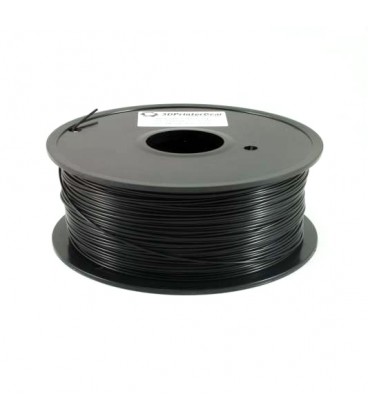http://en.wikipedia.org/wiki/Acrylonitrile_butadiene_styrene Finishing ABS parts:http://www.gopolymers.com/plastic-types/abs-plastic.html http://reprap.org/wiki/ABS http://en.wikipedia.org/wiki/Thermoplastic http://www.machinist-materials.com/comparison_table_for_plastics.htm ABS is the same material that LEGO uses to make their blocks. It is a strong material and reasonably easy to process. Prepare the heatbed with Kapton tape, the ABS sticks to it during printing and releases easy after cooling down. When you use a aluminum heatbed then you can use hairspray (extra strong?) instead of Kapton tape. http://blog.teil3.ch/post/2012/10/04/Hairspray-als-Haftbr%C3%BCcke-f%C3%BCr-die-Buildplattform-f%C3%BCr-3D-Drucker http://www.printanovo.com/en/fdm Method 1 - Acetone and ABS slurry You will need: A can of Silicone Conformal Coating Spray (typically used to protect circuit boards) 220 grit sandpaper An Exacto knife or razor blade. Here is how to finish your part: 1. Using your knife, trim off all of the external support. Do it as cleanly as possible. Spending a little time here will save you trouble in the next steps. 2. Use the sandpaper to sand the part as smooth as possible. You won't be able to eliminate every tiny ridge, but you can get it pretty good. You will probably have to do this by hand as an electric sander can heat up the ABS and ruin the part. 3. Spray the part with the conformal coating. Spray thin coats and they will dry in 30 minutes. Try to avoid thicker coats as they will take much longer to cure and will drip. 4. Each coat will end up really thin, so you will have to reapply the conformal coating a number of times to get a smooth finish. 5. Your part will probably be hygienic after two or three coats, but 10 coats will make it feel much smoother. This method will produce the silicone coating that you desire. Silicone is the material of choice for its hygienic properties and durability. Method 2 - Acetone and ABS slurry You will need: Some acetone (a couple of 2-4 ounces, 200ml) A glass jar with a metal lid Some leftover ABS filament in the same color as your part. A paint brush (natural bristles) 220 grit sandpaper An Exacto knife or razor blade. Here is how to finish your part: 1. Using your knife, trim off all of the external support. Do it as cleanly as possible. Spending a little time here will save you trouble in the next steps. 2. Use the sandpaper to sand the part as smooth as possible. You won't be able to eliminate every tiny ridge, but you can get it pretty good. You will probably have to do this by hand as an electric sander can heat up the ABS and ruin the part. 3. Prepare an ABS/Acetone slurry: 3a. Put the ABS filament in the jar. 3b. Pour in the acetone. 3c. Tighten the lid and shake until the acetone dissolves the ABS and forms a slurry. It is nice if it ends up the consistency of thin paint. 4. Paint the part with your slurry. This should seal the cracks and smooth out the finish. 5. Let the acetone evaporate and the part dry. It shouldn't take long. 6. The result will look like the above part. A Note About ABS - ABS is the material of choice for hard plastic toys. It is also used in children's toys, drink ware, and other body safe products. A smooth, non-porous ABS part is body safe, but the presence of cracks and crevices can harbor bacterial growth. Be sure your part is smooth and defect free before you use it.  http://3dprintergear.com.au/specialty-filaments/261-flame-retardant-black-filament-175mm-abs-1kg-22lbs.html This flame retardant ABS meets UL94-V0 specifications. No customer comments for the moment. |

